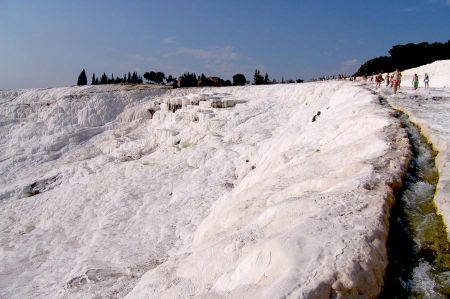Pamukkale - The Cotton Castle
Pamukkale (Hierapolis) is both, a magical and spectacular natural site, unique in the world and with its ancient ruins it is perhaps the most attractive spot for tourists.
Pamukkale is about 10 miles north of the town centre of Denizli and lies about 160 metres above the plateau of Menderes. This thermal area, which was visited 2000 years ago by kings and other important leaders, has been destroyed by earthquakes several times. Today’s mineral deposits of travertine at Pamukkale have been called the eighth wonder of the world. It is thought that these terraces have been created by nature over the last 15000 years. The water, which comes from springs in the earth, has a temperature of 34° and contains lots of minerals, the most important one being calcium bicarbonate. While running down into the Menderes valley, most of the carbon monoxide is removed and creates the white travertine. This is the reason for the name Pamukkale, which means white cotton castle.
Pamukkale is definitely the most important destination for one day trips from all over Turkey, attracting about 20000 visitors per day. Because of the huge number of visitors, Pamukkale has been partly destroyed and dried out. Now the local government is trying to prevent further destruction by introducing new regulations. Now bathing on the terraces is forbidden.
Alongside the terraces you will find an old Roman bath which is especially good for anybody suffering from any skin diseases. The most well-known is the pool of Kleopatra, where you can swim in crystal clear, blue water high above the sunken columns of the former palace of Kleopatra.
Red Water
About 5 kilometres north of Pamukkale, near Karahayit, you will find red travertine. The water, with a temperature of between 23.3 - 57.5 °C, contains magnesium and sulphur which is removed while flowing down the mountain. These minerals form the stones and have led to it being given the name Kirmizisu. Hotels, thermal baths, natural beauty and historical events and sites have made this a very popular tourist destination.
https://www.alaturka.info/en/turkey-country/aegean/1625-pamukkale-the-cotton-castle#sigProId1daf792ec4

